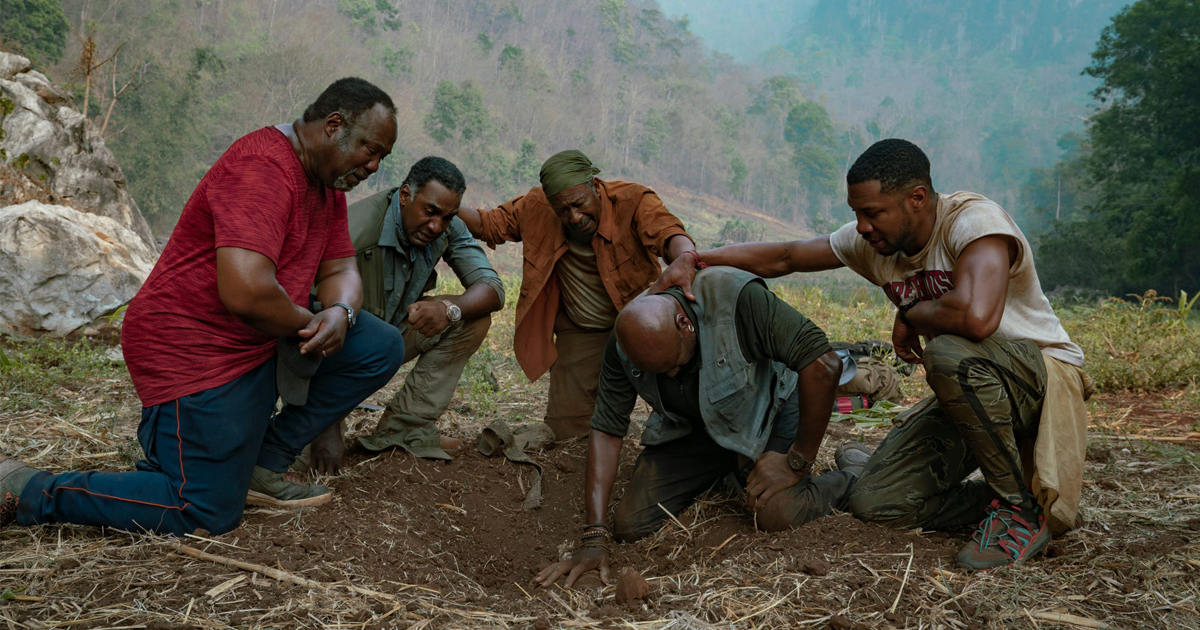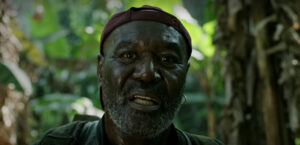
Spike Lee has been preaching to us through cinema for decades. But have we been listening? He has been laying down truths through film since his masterpiece. For many it has been easier to turn our heads, ignoring or denying there has been a problem at all. Lee has been persistent in creating films that prime the important discussions, open minds, and almost always demand some soul searching.
Da 5 Bloods could not have been released at a better time. Not only does Lee’s film address the history of racial injustice and systematic racism, but he also broadens the subject by addressing angles many have probably not even considered, how race factors into warfare. While Lee’s latest isn’t the most graceful of rides, it covers a lot of territory and really challenges viewers.
From the opening moments of Da 5 Bloods, it is clear this is not going to be the glorification of Vietnam as sometimes portrayed by Hollywood. The film opens with raw archival footage of the protests, the viciousness, and voices of the war. Some of the iconic images which are atrocious in their static form are brought to life with lesser-seen film footage that exposes just how barbaric war can be. Perspectives are provided that pull back the curtain on the treatment of African Americans during warfare, not just in Vietnam, but going to the early days of this nation. Black men were used to fight wars which they had no stake. Put on the front lines. Thankless and without recompense.

We are then introduced to the Bloods, the group of sixty-year-olds is on their way to Ho Chi Minh City to reunite and close up some loose end from their time together during the Vietnam war. As a squad of US Army soldiers of the 1st Infantry Division, there were five of them, but only four of the group reunite – Paul (Delroy Lindo), Otis (Clarke Peters), Eddie (Norm Lewis), and Melvin (Isiah Whitlock Jr.). The fifth, their squad leader “Stormin” Norman (Chadwick Boseman) is the purpose of reunion. He never made it back from the war, dying along the way. The four journey into the jungle to unbury their past by recovering the remains of their fallen friend as well as to retrieve a locker full of gold bars.
The film jumps back and forth between time periods using several different film stocks/aspect ratios to help convey the shifts in time. Crisp high definition digital footage is used for the modern-day scenes, Super 8 for their tour through the jungles, and grainier 16mm for the flashbacks to the war to capture the look of the era.
Lee’s intentions are ambitious, to say the least. He doesn’t just provide one point of view, we’re whisked around both war-era and modern Vietnam to intimately explore the effects of war from numerous perspectives, not just that of the Americans. By creating this human quilt Lee shows us the complexity of war and life in general. Mainly how each person’s view is their own and not always how it is perceived by others. It is just one of the themes that weave throughout. Because Lee tries to bite off so much the film does get clunky at times. There are clashing shifts in tone and style that do not combine as masterfully as they did in 2018’s BlackKklansman – one of Lee’s best. Individually they work, combining them has varying results.
During the early scenes, where the four reunited friends are reacquainting themselves, work the best. It is fun to watch these older gents getting their groove on, partying, telling jokes, and just chumming around in a way that old friends do. Through these scenes, we realize that although they share their time in the war, they’re lives lead them in many different directions. One of the most unexpected is the revelation that Paul as a loyal Trump supporter, red hat, and all. Paul’s MAGA hat is one of the devices Lee uses to inject more socio-political commentary. Here it provides an inlet to incorporate his feelings about Trump by voicing them through his characters’ words, creating for a spirited and timely discussion. Lee doesn’t pull punches – he knows what he wants to say and he says it.
This is done elsewhere in the film giving numerous insights on the war, racism, and prejudice, but from voices not typically heard in war-era films. These perspectives along with the interpolation historic footage may have you questioning some of your beliefs about the war and the country in general. Lee puts every inch of his canvas to work and it can become a bit cumbersome. It is so dense with thought-provoking topics that I literally wanted to pause the film to ponder on what I was hearing.

The film covers so much ground with moments of action, humor, extreme violence, and tenderness that at times felt slammed together with no attention to finesse. The second half, which knowingly winks to the camera as it borrows The Treasure of the Sierra Madre often feels like a completely different film. Furthermore, at times, I had the same feeling from one scene to the next. The social commentary remains, but then it becomes much more action-oriented. I cannot decide if Da 5 Bloods would have benefited from an expanded running time where some aspects could be explored more thoroughly or if an abbreviated more focused version of the story would have worked better. Or even maybe a few more weeks in the editing bay.
Newton Thomas Sigel’s cinematography is spectacular throughout. It helps contrast the painful pasts of these men against the setting of some of Vietnam’s breathtaking imagery. Bold hues are everywhere – in the cliffs, the rivers, the markets, and temples. Lee’s visual style is on display with his signature dolly and double dolly shots are put to good use here several times.
One shot, in particular, was elevated from what could have been a relatively mundane to quite memorable – my favorite of the film. As the four friends work their way through a Ho Chi Minh dance club, the dolly is used to create the feel of the guys almost gliding across the dance floor. The joy on their faces as they perform their dated dance moves, the sea of red flashing disco light beams, the onlooking audience and a DJ cranking out Marvin Gaye’s “Got To Give It Up” all amalgamate in the frame that captures pure glee. This is their last hurrah and it shows – a final reminder of their youth as they are about to put their lives in danger again.

There is also a mesmerizing tracking shot where Paul (Lindo) talks directly into the camera as he works his way through the jungle. We see into his soul as he makes the confessions of a conflicted man, struggling to fight his PTSD, whose been betrayed too many times to count but won’t stop fighting. Expect to hear his name mentioned frequently during awards season. His powerful work is the true standout among a very impressive ensemble.
The remaining squad (Peters, Lewis, and Whitlock Jr.) combined work both during modern-day and flashbacks (surprisingly they played the 20-something version of themselves in the war scenes as well) effectively convey the shared bond between them. They have some great chemistry which at times feels like a near-retirement age version of “Stand By Me” as they bicker, laugh, and show true affection for one another. Even when other elements of the film aren’t clicking, they always do. The four of them are the glue that holds the film together. In flashbacks, Boseman’s work as Norman is intense and forceful, making an impact while only on screen a fraction of the time of the other four.
Lee did his research here and does not hold back putting his anger, opinions, or artistic vision on front and center. Film fans will appreciate his references and homages to several classic war films. Fans of “The Wire” will get a huge kick out of one line delivery – I was hoping for it and when it happened it gave me great joy.
As I conclude writing, the film’s massive scope makes me worry I am doing the film a disservice through my omissions. There is just too much to potentially address here. I did not even touch upon the Apocolypse Now homages that could be broken down and analyzed at a deeper level than I do here. Da 5 Bloods will certainly be the subject of an array of college courses. Everything from a breakdown of Spike’s cinematic style to the racial injustices, or the influences of the war on modern Vietnam would have no trouble finding enough to discuss in this film. From the opening frames, the film had me wanting to pause and research to learn more about what I seeing. Some of which I was aware of before but was seeing in a new light, other aspects were completely new to me. It is eye-opening.
The film is not perfect in the least. It is hampered by uneven editing, some preposterous moments, and too many under-explored (or perhaps unnecessary) characters. As one scene ends the film keeps plowing forward to the next, sometimes jarringly. Even if you have trouble looking past the flaws “Da 5 Bloods” is well worth the watch for the just to listen to Spike preach. He has a lot of worth taking if we just take the time to listen.
Da 5 Bloods can be found streaming exclusively on Netflix.
Quick Scan
While clunky at times, Spike Lee’s ambitious film is packed full of strong performances, beautiful visuals, and thought-provoking ideas.

